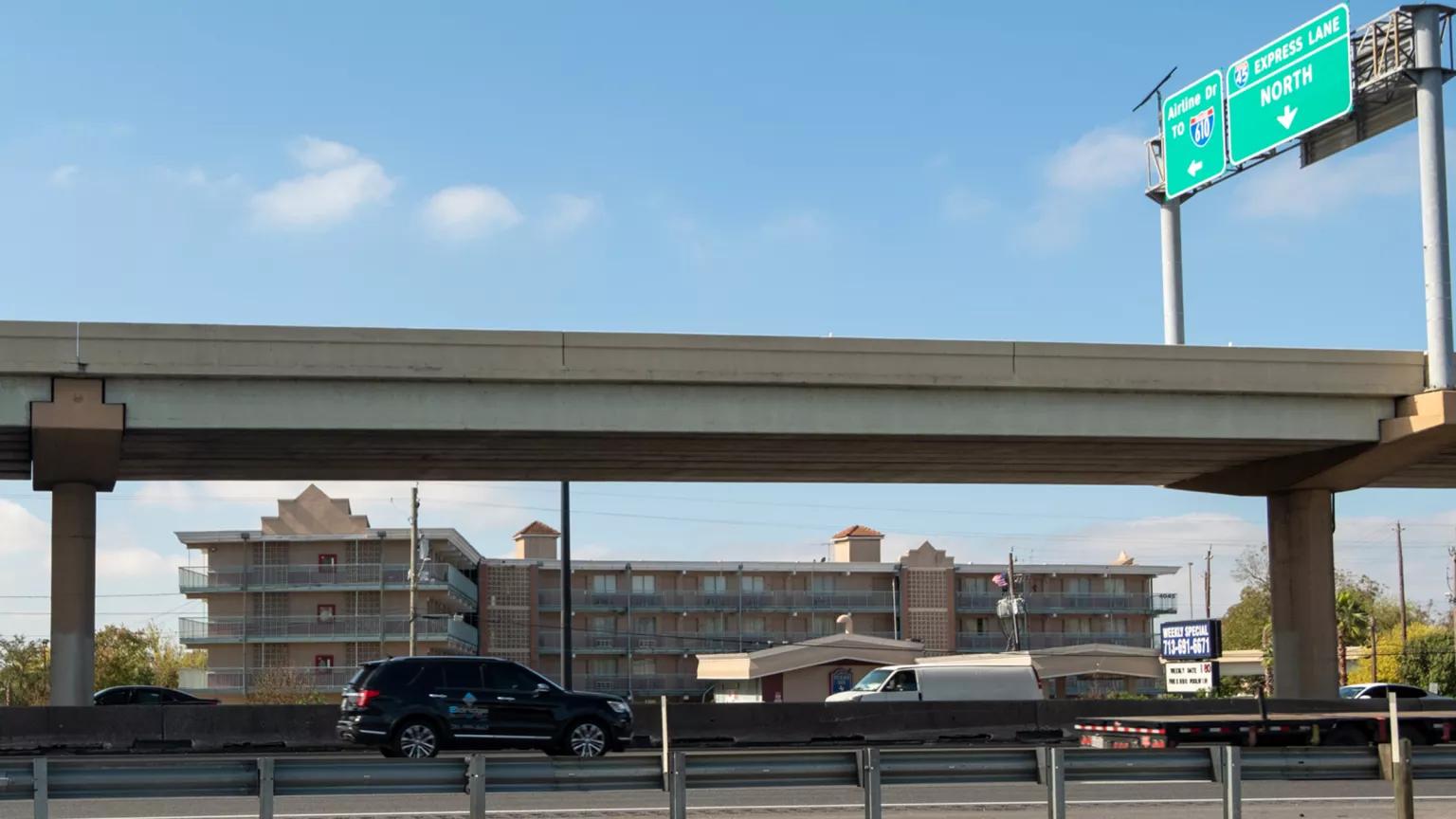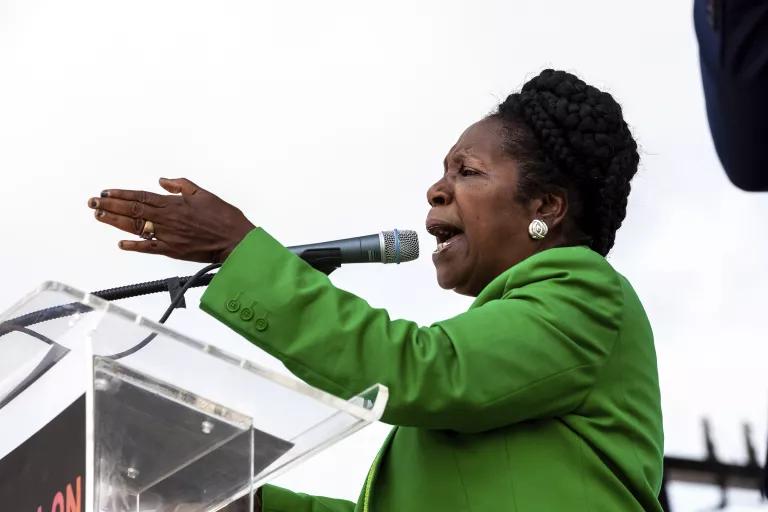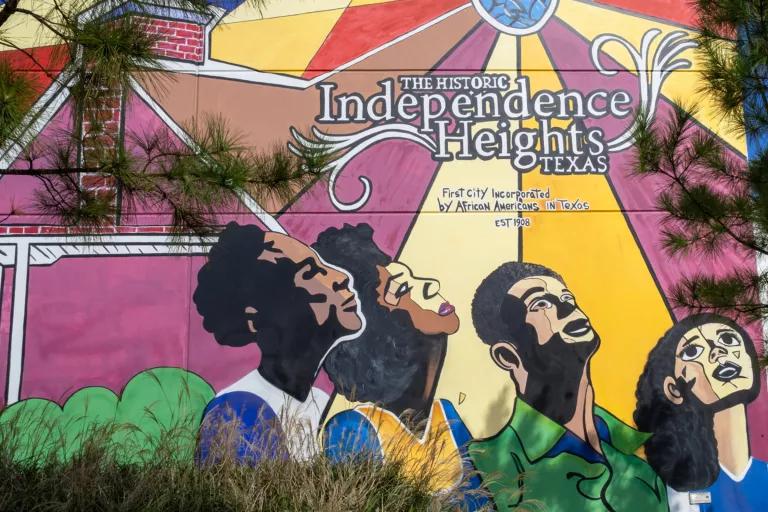How to Stop a Highway
Houston activists fuel a growing movement to increasingly center environmental justice in infrastructure and protect urban neighborhoods from endlessly expanding road projects.

Summer Taylor for NRDC
When Tanya Debose looks out at her Independence Heights neighborhood, she sees history threatening to repeat itself. It was 1924 when Debose’s great-grandfather bought land here, in the first African American municipality to be founded in Texas. By 1929, however, Independence Heights had been annexed into the city of Houston, and plans were laid for a major new highway to run right through its heart. Eventually, the road would displace a flourishing business district, more than 300 families, and her great-grandfather.
Even decades later, the community’s powerlessness to stop that destruction haunts her. “It was still the Jim Crow South,” she says, “and many people were probably not willing or brave enough to speak up. A lot of the families just had to move away.”
Today, as executive director of the Independence Heights Redevelopment Council, a group that fosters social and economic neighborhood development, Debose sees another disaster looming in the proposed $7.5 billion widening and realignment of Interstate 45. The freeway leads from the suburbs into Houston’s downtown. The Texas Department of Transportation (TxDOT), says the expansion, known as the North Houston Highway Improvement Project, would ease notoriously bad congestion. But residents see yet another catastrophic, ineffectual boondoggle in the works.
Effective or not, the I-45 expansion would displace some 1,300 homes, businesses, schools, and houses of worship—in many of the same Black and Latino neighborhoods already decimated by those earlier roads.
The difference, these days, is that communities like Independent Heights now have some power to advocate for themselves. Local grassroots organizations such as the anti-expansion groups LINK Houston, Air Alliance Houston, Stop TxDOT I-45, and others worked for more than a year to halt the Houston expansion over environmental impact concerns and its disproportionate effects on communities of color. Debose’s organization also sought legal assistance to have Independence Heights’ historic significance recognized in project impact studies. In March, in a surprising move, the Federal Highway Administration invoked the Civil Rights Act in requesting that TxDot pause its project for further review. This watershed moment inspired activists across several other states to push back on similar highway projects and marked an effort to center environmental justice in infrastructure work. “People are realizing that we can’t build our way out of congestion,” says Ines Sigel, LINK Houston’s interim executive director. “And we cannot simply continue to widen our freeways at the expense of Black and brown communities.”
That’s not a big ask. But it is an increasingly common one, as huge highway projects become part of our national conversation on race and equality. “Clearly, the Black Lives Matter movement has amplified this issue,” says Kyle Shelton, director of the University of Minnesota’s Center for Transportation Studies, and author of Power Moves: Transportation, Politics, and Development in Houston. “It has increased the pressure many officials feel around this process….Every day people are holding decision makers more accountable.”
That call for accountability is now reaching the highest levels: “It’s disproportionately Black and brown neighborhoods that were divided by highway projects plowing through them because they didn’t have the political capital to resist,” U.S. Transportation Secretary Pete Buttigieg told CNN’s Jake Tapper in December. “We have a chance to set that right.”
The origins and effects of highway expansion
Buttigieg’s approach upends our nation’s unquestioning devotion to roadbuilding that dates back to the Federal-Aid Highway Act of 1956. Conceived on the heels of World War II, the law promoted urban freeways, sometimes for a means of rapid evacuation, and often deliberately routed through communities of color. Many American cities got on board: Collectively, they’ve made room for roughly 30,000 new freeway lanes over the past quarter century, nearly doubling our highway capacity, and costing upward of $500 billion.
What did we get for all that money?
In terms of traffic relief, not much. The nonprofit Transportation for America found that congestion in those same cities actually grew by 144 percent over that time period, due in part to what experts call induced demand; more highway lanes entice more people to use them.
Then there’s the way this work has targeted communities of color. Our highway-building spree began at a time when courts were striking down the segregation policies that had kept Black people from moving into white neighborhoods. Freeway projects were often designed to continue that segregation. They were essentially built as barriers between Black and white communities.
So not only did these massive highways split city neighborhoods and create conditions that led to segregated enclaves with diminished opportunity for growth, but the additional pollution also placed residents at heightened risk of respiratory and cardiovascular problems.
And there are current projects doing more of the same. Consider Colorado’s plans to build nearly 200 miles of new traffic lanes over the next decade; the Rocky Mountain Institute projected that to be the equivalent of adding 70,000 new cars to the road.

Congresswoman Sheila Jackson Lee of Texas has been pushing the TxDOT for a more thorough analysis of the proposed I-45 expansion project and its impacts on the surrounding community.
Photo by Allison Bailey/NurPhoto via AP
Houston activists help set a new tone
This is why what happened in Houston was a watershed moment. Initially, grassroots groups pressed TxDOT to reexamine the human impacts of its proposed I-45 expansion with little success. In response, Congresswoman Sheila Jackson Lee, whose District 18 includes much of Houston, sent letters to TxDOT urging a more thorough evaluation of the project’s noise, pollution, and displacement impacts upon communities of color. Jackson Lee specifically cited the importance of Independence Heights, which is listed on the National Register of Historic Places as the first state-chartered community of former slaves. The congresswoman’s letters, and others from Houston activist groups, were forwarded to the Federal Highway Administration (FHWA).
Typically, the agency does not intervene outside of its normal decision-making schedule, so those watching saw Jackson Lee’s efforts as putting Secretary Buttigieg’s civil rights–sensitive comments to the test. And to their relief, the administration requested that TxDot pause its project for further review, invoking the Civil Rights Act. Three days later, Harris County, which encompasses Houston, sued TxDOT for failing to consider the impacts of displacement and air pollution on residents. Next, FHWA will send investigators to Texas.
TxDOT spokesperson Danny Perez defends his department, pointing to more than 300 public meetings where a majority of comments supported the I-45 project. But LINK Houston’s Sigel describes a “very flawed public engagement” that sidestepped neighborhood people who couldn’t attend because of work or childcare commitments. That might explain why officials were shocked by the fierce opposition from those communities. “This is the first time in a long time that there’s been this level of pushback against this type of project. People have had enough, and they’re getting louder about it,” she says.

Painted on Houston’s first Whole Foods 365, this mural is the first of its kind in the city to showcase the origins of the Independence Heights neighborhood as the first city incorporated by Black residents in the state of Texas.
Summer Taylor for NRDC
Signs of broader change
Given all of the harmful impacts, it’s hardly surprising that a growing segment of America has soured on big road projects, says Joseph DiMento, a University of California, Irvine law professor, and co-author of Changing Lanes: Visions and Histories of Urban Freeways. “Even people who early on supported building them are now thinking better of it.”
Thanks to shifting attitudes, at least 16 cities have already demolished or replaced their aging freeways with options like green spaces, and several others could face the same fate. Many communities are also putting the brakes on pending projects. They include Milwaukee, where residents fighting a $1 billion freeway expansion now have the support of many city council members. In Pennsylvania, citizens are beating back plans to drastically widen an interstate through the city of Harrisburg. On the West Coast, Oakland residents are campaigning for the removal of a freeway that dissects their downtown, and Portland, Oregon, activists are fighting a planned freeway-widening through the middle of a deep-rooted Black neighborhood.
Then, on November 15, President Joe Biden signed the Infrastructure Investment and Jobs Act into law. While it allocated significant sums for roads, it also pledged record levels of funding for alternative transportation, including $39 billion of new investment to modernize public transit, and $66 billion for rail. That marks a major step forward, according to Matthew Casale, environment campaigns director for the U.S. Public Interest Research Group, which compiles an annual report of highway boondoggles. In an e-mail, he writes, “The record investments in public transportation, passenger rail, electric buses, and transportation safety will help support a cleaner, healthier, and better working transportation future.”
Most of the recent changes would not be possible without the groundwork laid by citizens like Debose and the residents of Independence Heights. She says it’s high time that road planners stop considering communities like hers expendable. “As the first African American municipality in the state of Texas, we deserve to be here.”
This NRDC.org story is available for online republication by news media outlets or nonprofits under these conditions: The writer(s) must be credited with a byline; you must note prominently that the story was originally published by NRDC.org and link to the original; the story cannot be edited (beyond simple things such as grammar); you can’t resell the story in any form or grant republishing rights to other outlets; you can’t republish our material wholesale or automatically—you need to select stories individually; you can’t republish the photos or graphics on our site without specific permission; you should drop us a note to let us know when you’ve used one of our stories.
What Is Congestion Pricing?
Sharing the Road: Safer Streets Means Safe for Everyone
Public Transit Just Helped Save America. Now America Needs to Return the Favor.